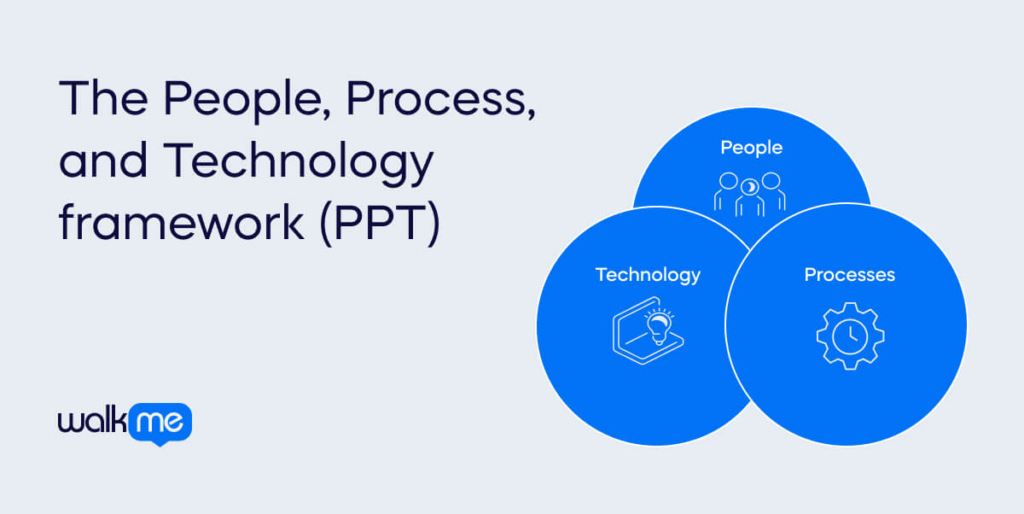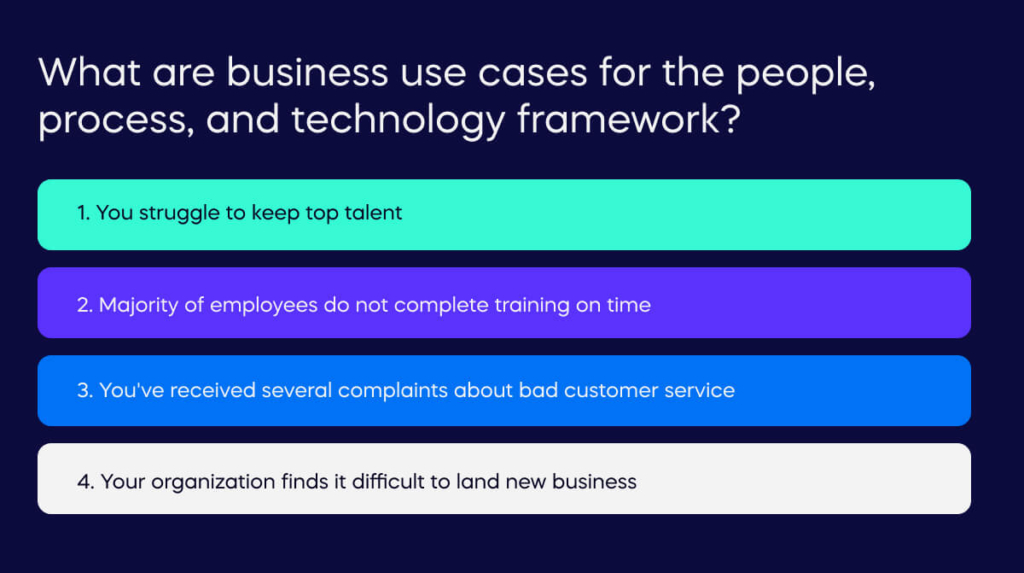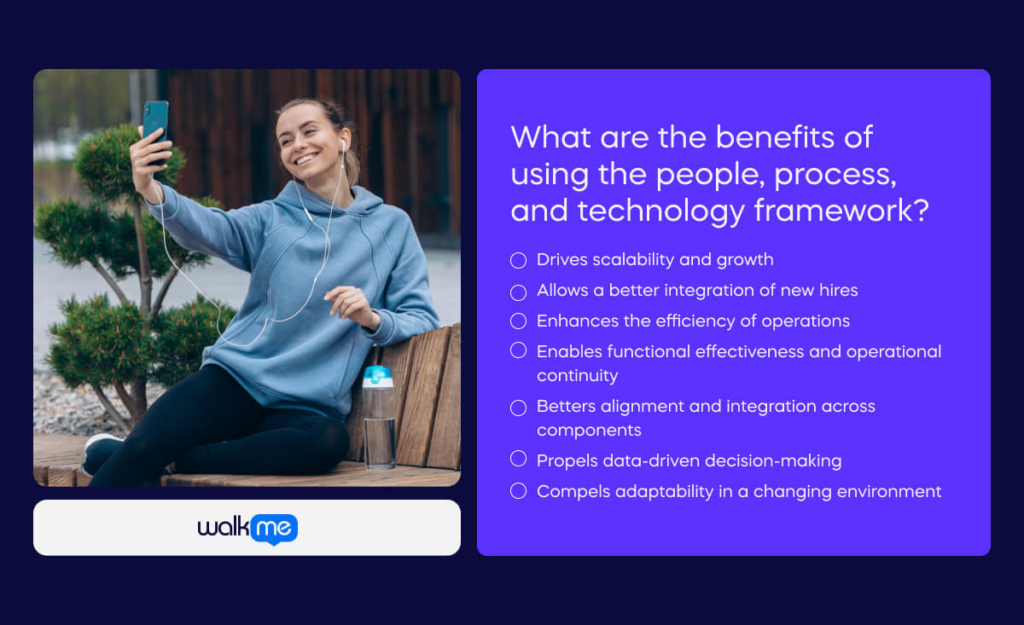Digital transformation continues to sweep across industries. Businesses will embrace new technologies and adapt processes to stay competitive. Statista predicts global spending on digital transformation will reach $3.4 trillion by 2026. However, businesses need a sustainable growth model to remain competitive in the long term.
This combines leadership, digital transformation, organizational talent, and management practices. The people, process, and technology (PPT) framework offers a strategic approach to navigating this transformation by addressing the interaction between people, processes, and technology.
By using this framework, organizations can unlock digital transformation’s potential. They can also ensure seamless integration, streamlined workflows, and enhanced employee productivity.
In this article, we will explain the PPT framework and why it is important. We will also discuss its origins, business use cases, and best practices. We will also touch on the benefits and challenges of implementing this framework.
What is the people, process, and technology framework?

The people, process, and technology (PPT) framework is a methodology that balances these three elements to drive action. People perform specific tasks for an organization. They often use processes and technology to streamline and enhance these tasks.
Each element—people, process, and technology—is essential for business transformation and management.
People execute tasks, processes provide structure and workflow, and technology optimizes these processes. Balancing these three components is vital for efficiency. Maintaining good relationships among them ensures smooth operations and promotes effective operational transformation within the organization.
Why is the people, process, and technology framework important?
The people, process, and technology framework is important as it focuses on enhancing a business’s collective interaction. It recognizes that technology implementation must align with people’s skills and existing processes.
Motivated employees become most effective when supported by current technology and efficient processes. Businesses should see these elements as interdependent, each vital to the organization’s success.
Using the PPT framework, businesses can create a strategy that aligns people, processes, and technology with their goals. This alignment fosters business agility, innovation, and competitiveness and enables organizations to thrive in complex and evolving business landscapes.
What is the origin of the people, process, and technology framework?
The concept of the people, process, and technology framework began in the early 1960s. Business management expert Harold Leavitt introduced it in his paper ‘Applied Organization Change in Industry.’
His original diamond model included four elements: people, structure, tasks, and technology. But it did not consider their interactions. In this model, people were the workers. The structure was how they were organized and the tasks they did. Technology included the tools they used.
Over time, the diamond became a triangle. Structure and tasks were combined to form processes. In the 1990s, Bruce Schneier popularized this framework in the information security industry. Through his papers and radio show, he emphasized the framework’s importance in the field of IT.
The people, process, and technology framework explained
The PPT framework focuses on the interaction between three elements. These are people, processes, and technology.
People do the work, and processes make the work more efficient. Technology helps people complete tasks and automates processes. Businesses can achieve organizational efficiency by balancing these three and optimizing their relationships.
So, here is a further explanation of how those three components should work in practice:
People: the main resource
In the people, process, and technology (PPT) framework, people refer to a firm’s human resources. They perform the tasks necessary for operations. One primary responsibility is bringing suitable individuals on board. Companies must identify key personnel with the abilities, expertise, and mindset for specific jobs.
But, these essential employees are often busy or engaged elsewhere. Managers might have to hire new staff, use workers from other projects, or delegate tasks to external consultants or agencies. These significant choices impact the success of the PPT framework.
Clear role definitions ensure everyone knows their responsibilities. They also assist in decision-making, selecting technology, process deployment, and staff hiring. Many businesses focus on technology and processes, overlooking the people involved. Thus, having the right team with strong communication skills is crucial.
Businesses need their people to buy into the process, understanding what they need to do, why they are doing it, and how changes will affect them. Implementing new technology or processes without full buy-in can lead to slow adoption or sub-optimal usage. Proper employee training can empower employees when necessary.
Process: the well-defined path
An organization’s efficiency and adaptability depend on its processes. While people are the core of any successful business, the processes a business creates and implements are very important. Well-defined processes are crucial for integrating human talent with technological capabilities.
Processes are more than just workflows; they define how an organization functions. A clear and adaptable process design, often contained in standard operating procedures (SOPs), ensures consistency and efficiency. It maintains quality across all levels of the organization.
Processes must evolve to sustain efficiency. They require regular monitoring and feedback from those directly involved, which allows organizations to maintain their operational efficiency and effectiveness.
Organizations can use the business process re-engineering (BPR) methodology to do this. This involves fundamentally rethinking core business processes to enhance productivity and quality. This approach aligns processes with market needs and internal dynamics.
Incorporating Lean and Agile methodologies like this fosters a culture of adaptability. These frameworks create a guide for process optimization. It ensures businesses can respond to evolving challenges and opportunities.
Technology: The enabling tool
Technology provides the tools that people need to implement processes. It helps automate certain parts of the process, thus creating the most impact. Shiny new tools can be tempting, but organizations must ensure that the technology fits into their organizational culture.
Often, businesses focus on investing heavily in technology to gain a competitive edge. But they overlook the importance of their people and processes. As a result, they might try to match their personnel and procedures with this new technology, often with suboptimal results. So, technology alone is not enough. It needs capable individuals following well-defined processes to produce the desired outcome.
Thus, technology should be the final consideration after learning about the problem, recruiting and training suitable talent, and establishing clear process requirements. If people are not adequately trained or the process does not effectively use these tools, it will not yield a good return on investment.
Using technology alone will not solve problems. Businesses need to define their objectives and establish processes. They also need to train their employees to maximize technology’s potential.
What are business use cases for the people, process, and technology framework?

You can mold the people, process, and technology framework to solve various problems. Let’s look at some of its use cases:
1. You struggle to keep top talent
People: Examine the reasons why you cannot keep strong talent. Conduct exit interviews with these employees and key team members to understand their reasons for departure.
Process: Once you have this feedback, consider whether you need to create a different performance appraisal process for these individuals. You also need to look at your current reward programs and update them to enhance employee retention.
Technology: Use analytics software to identify trends in when these individuals leave. Use this data to make any changes to your current policies and procedures.
2. Majority of employees do not complete training on time
People: Assess your firm’s current training methods. Review the training materials to see whether these are easy to understand. Meet with these types of employees to learn why they do these things.
Process: After receiving this feedback and reviewing the existing training process, consider what needs to change. Should your training materials be clearer? Do employees need more time to complete training? Are their managers giving them this time?
Do employees have less time to complete training as they are too busy with routine tasks? Should there be any consequences for completing the training late? Are there any other issues that result in changing the current process?
Technology: Consider using an online training provider to improve the completion rate. These training providers can also make mundane topics interesting. Some also use gamification to establish a competitive element in completing training on time. Based on future data from this provider, assess whether you can reward individuals for completing training earlier.
3. You’ve received several complaints about bad customer service
People: Review the current skill set of your current customer service team. Find out whether everyone can deal with these types of queries well. Would they enjoy further training? Organize a meeting with them to discover the causes of these complaints. Understand whether we could have done more for the customer.
Process: Look at the current customer service and complaints procedures. Do a root cause analysis of all complaints where a customer mentions bad services. See whether you identify any themes that suggest any hurdles in current processes. Aim to resolve these problems and reduce these types of complaints.
Technology: Adopt analytics software to assess whether these types of complaints have come in at a certain time. Also consider using AI technology or a customer relationship management (CRM) tool. These can help in responding effectively to customers. They can also organize queries so you can use them to train future customer service employees.
4. Your organization finds it difficult to land new business
People: Look at the sales expertise of your current individuals. Would they benefit from further training? Also, are you encouraging them to be innovative and creative? Are they looking for deals in unique markets that differ from their competitors?
How do other team members support the sales department to win more deals? Conduct interviews with salespeople and managers from different departments to get this feedback.
Process: Assess the current sales processes. Look for any hurdles or gaps that might cause business loss. Learn whether good incentives exist for individuals who bring in more regular business.
Is progress tracked and rewarded? Are sales an effort of the entire organization? Consider whether other employees could help more. This could be through helping with community events to increase brand recognition or building strategic partnerships.
Technology: Consider using sales enablement tools to help the sales team close deals faster. Using a CRM, create a database of existing clients and identify whether any of them could offer referrals to your businesses. You could also buy a market intelligence tool, which can keep your employees informed about the latest market and business trends.
Best practices to implement the people, process, and technology framework

Now that you know what the framework can help you achieve, how can you install it?
Here are the main best practices you need to help you use it within your business:
Identify the main organizational challenges first
Focus on assessing the interactions between people, processes, and technology. Then, you can pinpoint the most significant challenges within your organization. This critical evaluation is key to addressing impactful issues.
Issues related to creativity often stem from the synergy between people and their environment. Foster innovation by optimizing cross-functional collaboration and leveraging technology.
Assess existing technology
Before investing in new technology, check your current solutions. Often, organizations underutilize existing technology. Conduct a comprehensive analysis to uncover untapped functionalities that can enhance processes.
Build a competent team to drive the change
Plan a team that understands organizational goals and is committed to achieving them. This team should comprise leaders, key stakeholders, project managers, and technical coordinators. It should also include individual contributors with the necessary skill sets.
Successful change management ensures that every stakeholder feels valued and engaged. Implement a PPT framework that encourages ownership and knowledge sharing across various departments and levels.
Look at your company’s current culture
Check your company culture’s role in facilitating effective communication and change. Implement training programs to equip employees with essential skills. This will also ensure transparency in decision-making processes.
Create a software implementation plan
Develop a clear software implementation plan outlining timelines, goals, processes, and required resources. Operationalize workflows to streamline technology integration and automate tasks. You can also use it to enhance feedback mechanisms for sustainable success.
Recognize the interconnected nature of people, processes, and technology within the PPT framework. Optimize this synergy to improve efficiency and support for your plan.
Don’t forget about the importance of training in driving adoption
Invest in user experiences, in-app guidance, and self-help support to speed up ramp-up times. It will also reduce dependencies and drive digital adoption of IT technology and software investments. Use tools like in-app nudges, product tours, and interactive flows for contextual learning and enhanced technology expertise.
What are the benefits of using the people, process, and technology framework?

The most important benefits of using the people, process, and technology framework are:
Drives scalability and growth
Organizations face constant demands to scale and expand. However, this growth can lead to inefficiencies and bottlenecks.
The process, people, and technology (PPT) framework supports scalability by implementing flexible processes and technology solutions. This proactive approach prevents operational inefficiencies that could hinder business growth.
Allows a better integration of new hires
Expansion often requires hiring new employees. The PPT framework facilitates seamless integration and employee onboarding. It does this without compromising operational quality as organizations grow.
Enhances the efficiency of operations
The PPT framework enhances operational efficiency by eliminating bottlenecks, redundancies, and inefficiencies.
It can streamline workflows, automate tasks, and optimize resource allocation. This results in improved employee productivity and customer satisfaction. It can also lead to reduced costs.
Enables functional effectiveness and operational continuity
The PPT framework equips organizations with the tools to maintain functional effectiveness and avoid disruptions in essential processes.
Organizations optimize resource use and streamline workflows by understanding how the three components of people, process, and technology work together. They can also enhance productivity, leading to higher customer satisfaction.
Betters alignment and integration across components
Aligning people, processes, and technology ensures a cohesive organizational ecosystem. This alignment fosters collaboration, reduces silos, and enhances communication among teams and departments. In this way, organizations ensure everyone works towards common goals.
Propels data-driven decision-making
The PPT framework provides organizations with vital insights and data-driven analysis to support decision-making. By adopting key metrics, organizations can identify trends and measure performance. They can also stay responsive to customer needs, driving business success.
Compels adaptability in a changing environment
In today’s dynamic business environment, organizations must adapt quickly to technological advancements and market changes to maintain a competitive edge.
The PPT framework encourages continuous evaluation and improvement of processes and technology. This empowers organizations to embrace change and stay agile in evolving industries.
What are the challenges of using the people, process, and technology framework?

But, you also need to keep in mind the limitations of the people, process, and technology framework:
Technological integration
Integrating new technology with existing systems often poses significant challenges. Incompatibilities can cause delays and increase costs.
To overcome integration challenges, check the new technology’s compatibility with your current infrastructure. Systems integration services can also help ensure a smooth process.
The scale of change
Unifying and managing people, processes, and technology as a single system can seem overwhelming. This is especially true if the company’s culture isn’t ready for such a change.
Resource constraints, particularly the limited scalability of human resources, complicate the problem. Each team might operate with its own people, processes, and technology, making implementation harder and more time-consuming.
Resistance from employees
Implementing new processes is often challenging because employees resist change. Users often prefer familiar processes, even if they aren’t ideal.
Motivate employees to learn new ways of doing things by involving them early in the process. Provide training and communicate the benefits of the latest technology to help them understand its value.
Enhance technology and process adoption with in-app guidance for your team
The three core parts of building a modern workplace are people, processes, and technology. To succeed, you need to improve and keep updating your management structure. The framework’s success depends on how well your current structure allows for changes.
People often resist change, so it’s crucial to work on your company culture. Making sure your culture accepts new changes will make it easier to implement other parts of the framework.
To boost digital adoption, use WalkMe’s digital adoption platform. This platform helps create and deploy in-app training content, including interactive walkthroughs, tooltips, and self-help resource centers. It also offers users immediate self-service. It uses a natural language chat interface to find information, helping you complete tasks faster.
WalkMe’s analytics show how people engage with and adopt your applications and digital workflows. This helps identify problem areas, underused features, and incomplete tasks.
Its in-app guidance supports many ways to complete a task. This considers conditional logic, error handling, and the ability to start at any step of the process. This improves the customer experience and makes adoption smoother.

